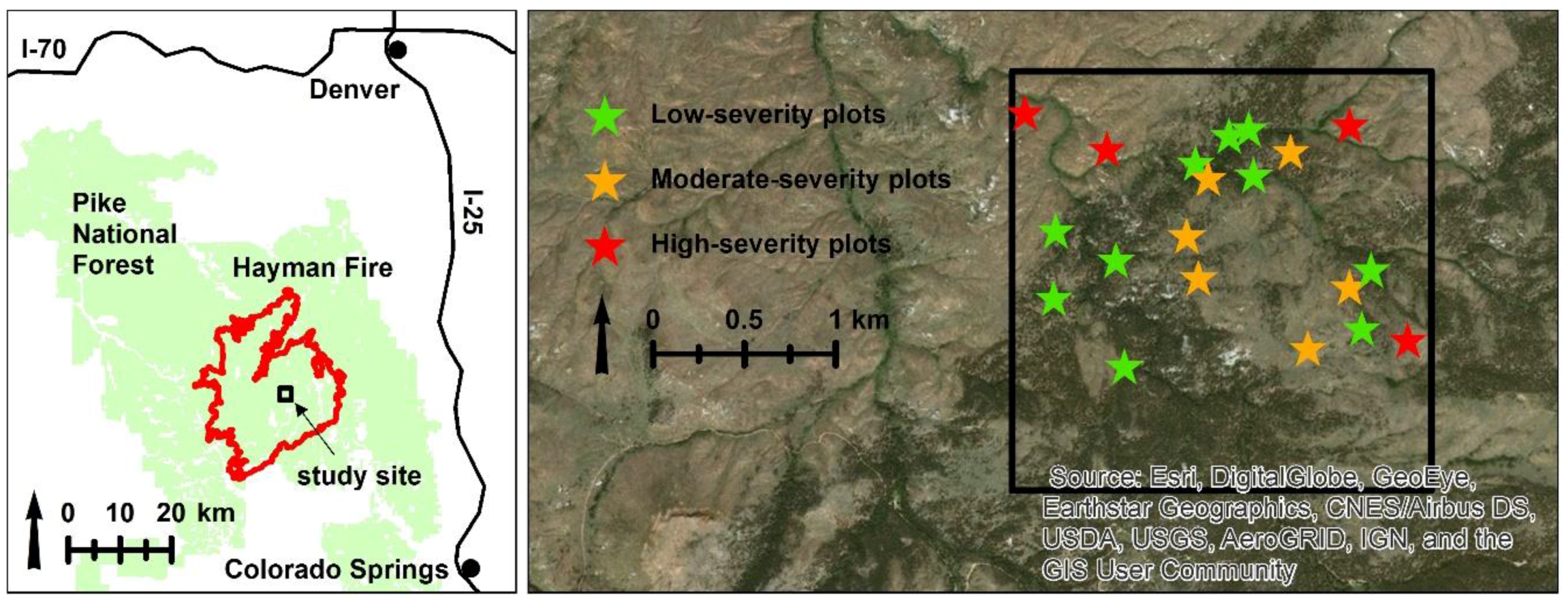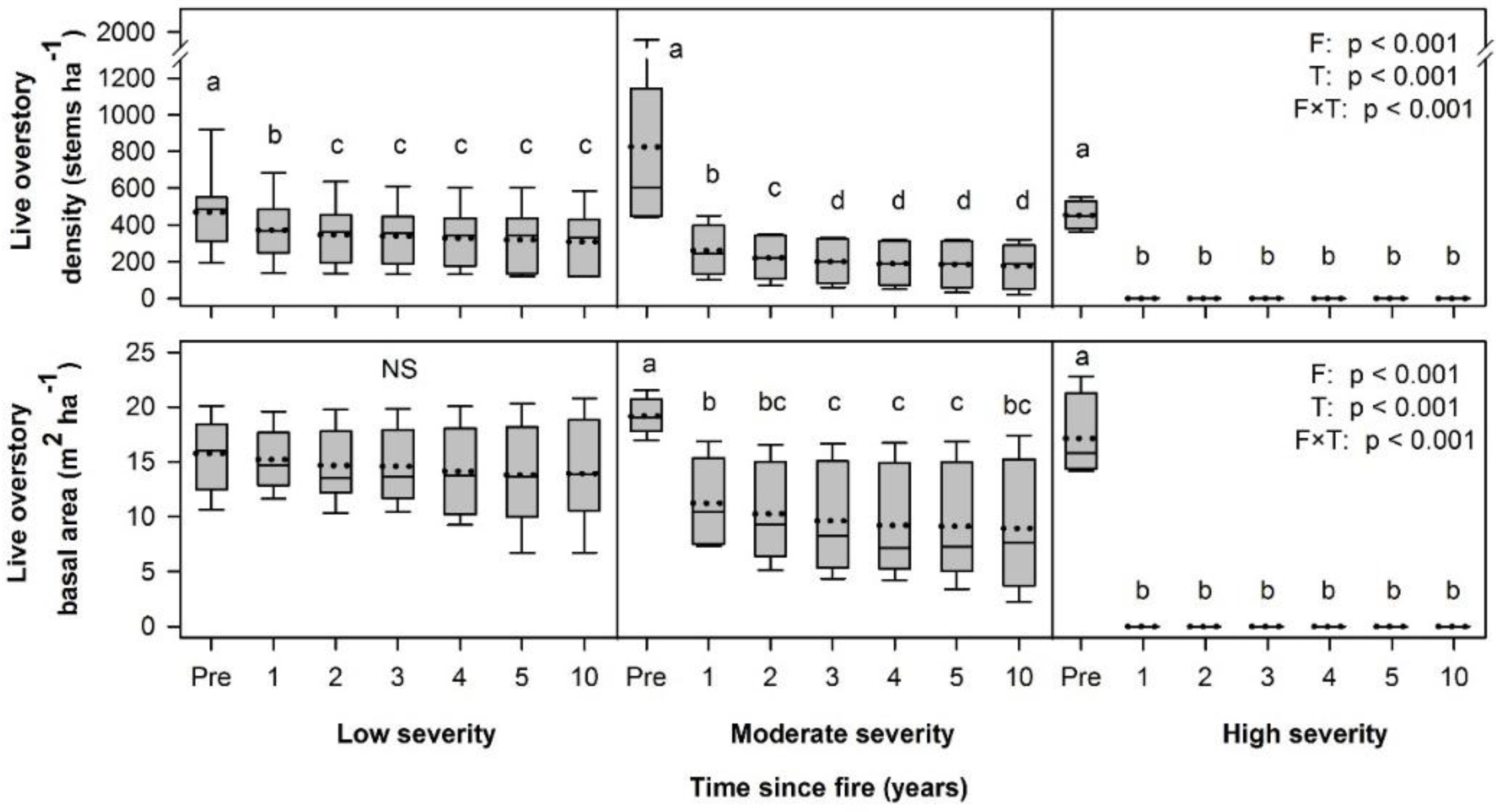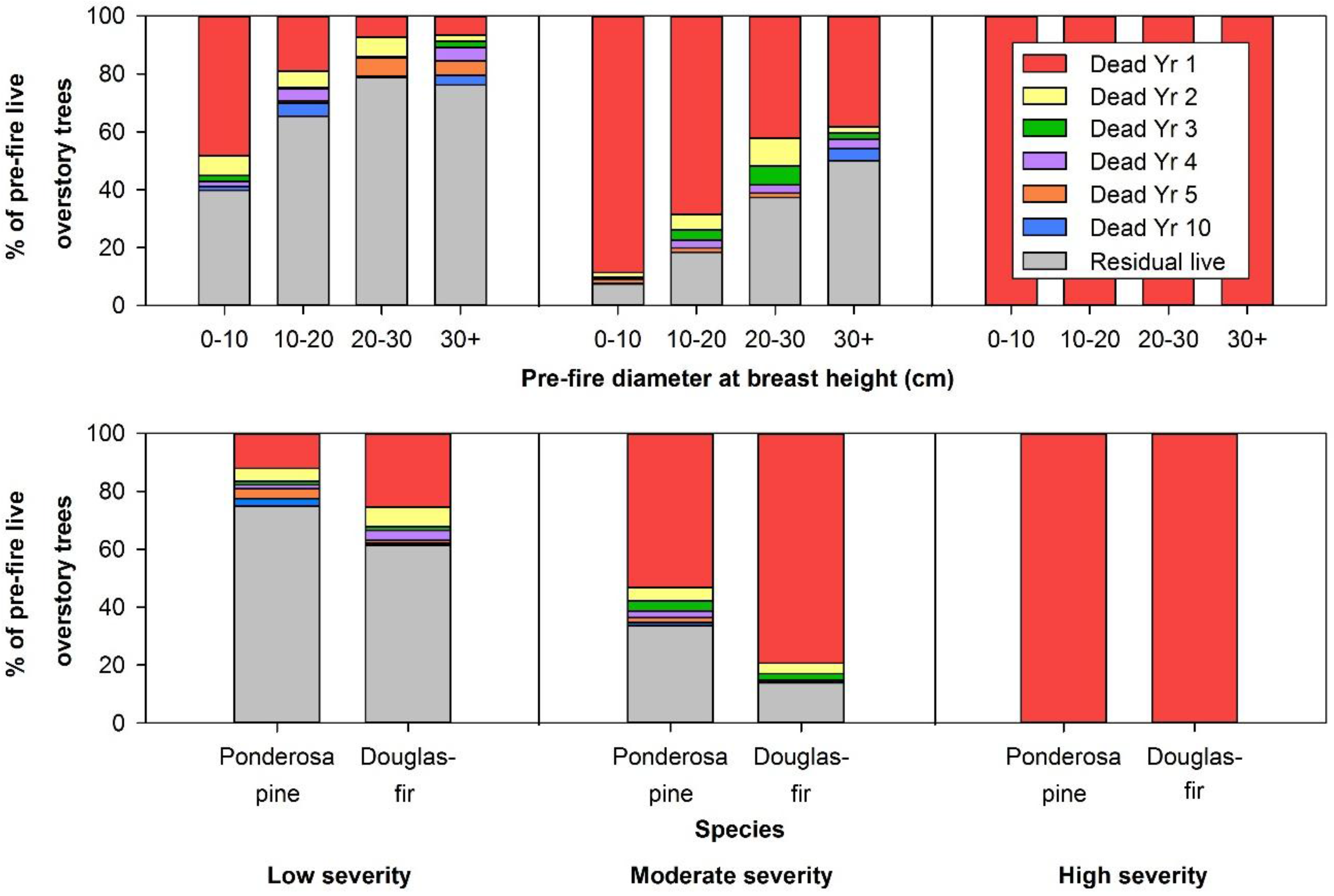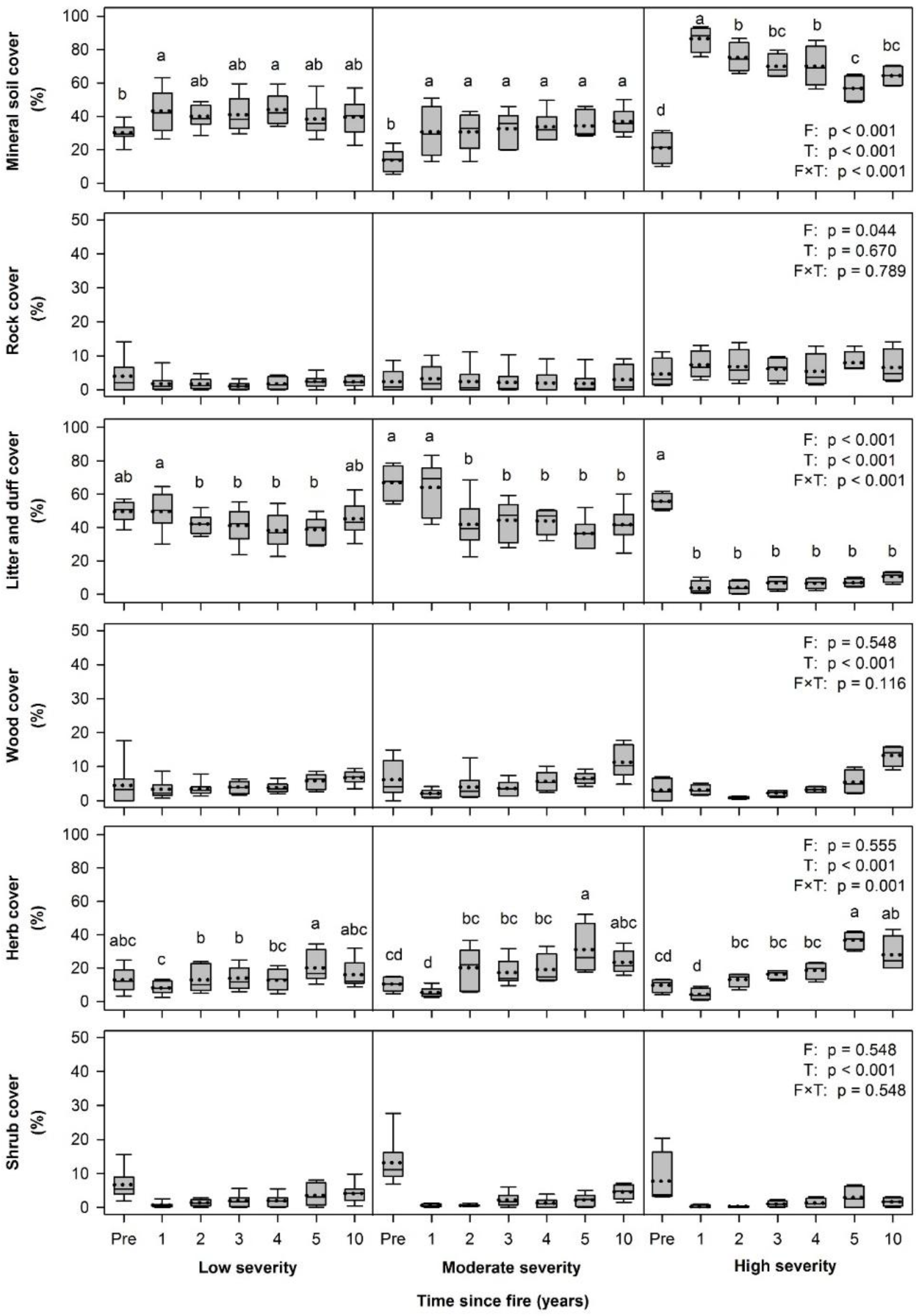Overstory Structure and Surface Cover Dynamics in the Decade Following the Hayman Fire, Colorado
Abstract
:1. Introduction
2. Materials and Methods
2.1. Study Site and Study Plots
2.2. Data Collection
2.3. Data Calculations and Analyses
3. Results
3.1. Live Overstory Structure
3.2. Dead Overstory Structure
3.3. Surface Cover
4. Discussion
4.1. Live Overstory Structure
4.2. Dead Overstory Structure
4.3. Surface Cover
4.4. Study Design Considerations
5. Conclusions and Recommendations
Acknowledgments
Author Contributions
Conflicts of Interest
References
- Keane, R.E.; Ryan, K.C.; Veblen, T.T.; Allen, C.D.; Logan, J.; Hawkes, B. Cascading Effects of Fire Exclusion in Rocky Mountain Ecosystems: A Literature Review; General Technical Report RMRS-GTR-91; US Department of Agriculture, Forest Service, Rocky Mountain Research Station: Fort Collins, CO, USA, 2002; p. 24.
- Swetnam, T.W.; Baisan, C.H. Historical fire regime patterns in the southwestern United States since AD 1700. In Fire Effects in Southwestern Forests: Proceedings of the Second La Mesa Fire Symposium; Allen, C.D., Ed.; General Technical Report RM-286; US Department of Agriculture, Forest Service, Rocky Mountain Research Station: Fort Collins, CO, USA, 1996; pp. 11–32. [Google Scholar]
- Hessburg, P.F.; Agee, J.K.; Franklin, J.F. Dry forests and wildland fires of the inland Northwest USA: Contrasting the landscape ecology of the pre-settlement and modem eras. For. Ecol. Manag. 2005, 211, 117–139. [Google Scholar] [CrossRef]
- Westerling, A.L.; Hidalgo, H.G.; Cayan, D.R.; Swetnam, T.W. Warming and earlier spring increase western US forest wildfire activity. Science 2006, 313, 940–943. [Google Scholar] [CrossRef] [PubMed]
- Litschert, S.E.; Brown, T.C.; Theobald, D.M. Historic and future extent of wildfires in the Southern Rockies Ecoregion, USA. For. Ecol. Manag. 2012, 269, 124–133. [Google Scholar] [CrossRef]
- Westerling, A.L. Increasing western US forest wildfire activity: Sensitivity to changes in the timing of spring. Philos. Trans. Royal Soc. B-Biol. Sci. 2016, 371, 20150178. [Google Scholar] [CrossRef] [PubMed]
- Battaglia, M.A.; Gannon, B.; Brown, P.M.; Fornwalt, P.J.; Cheng, A.S.; Huckaby, L.S. Changes in forest structure since 1860 in ponderosa pine dominated forests of the Colorado and Wyoming Front Range, USA. For. Ecol. Manag. 2018. submitted. [Google Scholar]
- Keeley, J.E. Fire intensity, fire severity and burn severity: A brief review and suggested usage. Int. J. Wildland Fire 2009, 18, 116–126. [Google Scholar] [CrossRef]
- Graham, R.T. Hayman Fire Case Study; General Technical Report RMRS-GTR-114; US Department of Agriculture, Forest Service, Rocky Mountain Research Station: Ogden, UT, USA, 2003; p. 396.
- Lentile, L.B.; Smith, F.W.; Shepperd, W.D. Patch structure, fire-scar formation, and tree regeneration in a large mixed-severity fire in the South Dakota Black Hills, USA. Can. J. For. Res. 2005, 35, 2875–2885. [Google Scholar] [CrossRef]
- Kokaly, R.F.; Rockwell, B.W.; Haire, S.L.; King, T.V.V. Characterization of post-fire surface cover, soils, and burn severity at the Cerro Grande Fire, New Mexico, using hyperspectral and multispectral remote sensing. Remote Sens. Environ. 2007, 106, 305–325. [Google Scholar] [CrossRef]
- Hayes, J.J.; Robeson, S.M. Relationships between fire severity and post-fire landscape pattern following a large mixed-severity fire in the Valle Vidal, New Mexico, USA. For. Ecol. Manag. 2011, 261, 1392–1400. [Google Scholar] [CrossRef]
- Casas, A.; Garcia, M.; Siegel, R.B.; Koltunov, A.; Ramirez, C.; Ustin, S. Burned forest characterization at single-tree level with airborne laser scanning for assessing wildlife habitat. Remote Sens. Environ. 2016, 175, 231–241. [Google Scholar] [CrossRef]
- Harrington, M.G. Predicting Pinus ponderosa mortality from dormant season and growing season fire injury. Int. J. Wildland Fire 1993, 3, 65–72. [Google Scholar] [CrossRef]
- Keyser, T.L.; Lentile, L.B.; Smith, F.W.; Shepperd, W.D. Changes in forest structure after a large, mixed-severity wildfire in ponderosa pine forests of the Black Hills, South Dakota, USA. For. Sci. 2008, 54, 328–338. [Google Scholar]
- Hood, S.M.; Smith, S.L.; Cluck, D.R. Predicting mortality for five California conifers following wildfire. For. Ecol. Manag. 2010, 260, 750–762. [Google Scholar] [CrossRef]
- Dunn, C.J.; Bailey, J.D. Temporal dynamics and decay of coarse wood in early seral habitats of dry mixed conifer forests in Oregon's eastern Cascades. For. Ecol. Manag. 2012, 276, 71–81. [Google Scholar] [CrossRef]
- Roccaforte, J.P.; Fulé, P.Z.; Chancellor, W.W.; Laughlin, D.C. Woody debris and tree regeneration dynamics following severe wildfires in Arizona ponderosa pine forests. Can. J. For. Res. 2012, 42, 593–604. [Google Scholar] [CrossRef]
- Passovoy, M.D.; Fulé, P.Z. Snag and woody debris dynamics following severe wildfires in northern Arizona ponderosa pine forests. For. Ecol. Manag. 2006, 223, 237–246. [Google Scholar] [CrossRef]
- Chambers, M.E.; Fornwalt, P.J.; Malone, S.L.; Battaglia, M.A. Patterns of conifer regeneration following high severity wildfire in ponderosa pine - dominated forests of the Colorado Front Range. For. Ecol. Manag. 2016, 378, 57–67. [Google Scholar] [CrossRef]
- Welch, K.R.; Safford, H.D.; Young, T.P. Predicting conifer establishment post wildfire in mixed conifer forests of the North American Mediterranean-climate zone. Ecosphere 2016, 7, e01609. [Google Scholar] [CrossRef]
- Chambers, C.; Mast, J. Ponderosa pine snag dynamics and cavity excavation following wildfire in northern Arizona. For. Ecol. Manag. 2005, 216, 227–240. [Google Scholar] [CrossRef]
- Koprowski, J.L.; Leonard, K.M.; Zugmeyer, C.A.; Jolley, J.L. Direct effects of fire on endangered Mount Graham red squirrels. Southwest. Nat. 2006, 51, 59–63. [Google Scholar] [CrossRef]
- Kotliar, N.B.; Reynolds, E.W.; Deutschman, D.H. American three-toed woodpecker response to burn severity and prey availability at multiple spatial scales. Fire Ecol. 2008, 4, 26–45. [Google Scholar] [CrossRef]
- Johansen, M.P.; Hakonson, T.E.; Breshears, D.D. Post-fire runoff and erosion from rainfall simulation: Contrasting forests with shrublands and grasslands. Hydrol. Process. 2001, 15, 2953–2965. [Google Scholar] [CrossRef]
- Benavides-Solorio, J.d.D.; MacDonald, L.H. Measurement and prediction of post-fire erosion at the hillslope scale, Colorado Front Range. Int. J. Wildland Fire 2005, 14, 457–474. [Google Scholar] [CrossRef]
- Wagenbrenner, J.W.; Robichaud, P.R. Post-fire bedload sediment delivery across spatial scales in the interior western United States. Earth Surf. Process. Landf. 2014, 39, 865–876. [Google Scholar] [CrossRef]
- Brown, J.K.; Reinhardt, E.D.; Kramer, K.A. Coarse Woody Debris: Managing Benefits and Fire Hazard in the Recovering Forest; General Technical Report RMRS-GTR-105; US Department of Agriculture, Forest Service, Rocky Mountain Research Station: Ogden, UT, USA, 2003; p. 16.
- Coppoletta, M.; Merriam, K.E.; Collins, B.M. Post-fire vegetation and fuel development influences fire severity patterns in reburns. Ecol. Appl. 2016, 26, 686–699. [Google Scholar] [CrossRef] [PubMed]
- Stevens-Rumann, C.; Morgan, P. Repeated wildfires alter forest recovery of mixed-conifer ecosystems. Ecol. Appl. 2016, 26, 1842–1853. [Google Scholar] [CrossRef] [PubMed]
- Stevens-Rumann, C.S.; Sieg, C.H.; Hunter, M.E. Ten years after wildfires: How does varying tree mortality impact fire hazard and forest resiliency? For. Ecol. Manag. 2012, 267, 199–208. [Google Scholar] [CrossRef]
- Abella, S.R.; Fornwalt, P.J. Ten years of vegetation assembly after a North American mega fire. Glob. Chang. Biol. 2015, 21, 789–802. [Google Scholar] [CrossRef] [PubMed]
- Dunn, C.J.; Bailey, J.D. Temporal fuel dynamics following high-severity fire in dry mixed conifer forests of the eastern Cascades, Oregon, USA. Int. J. Wildland Fire 2015, 24, 470–483. [Google Scholar] [CrossRef]
- Addington, R.N.; Aplet, G.H.; Battaglia, M.A.; Briggs, J.S.; Brown, P.M.; Cheng, T.S.; Dickinson, Y.; Feinstein, J.A.; Fornwalt, P.J.; Gannon, B.; et al. Principles and Practices for the Restoration of Ponderosa Pine and Dry Mixed-Conifer Forests of the Colorado Front Range; General Technical Report RMRS-GTR-373, US Department of Agriculture, Forest Service, Rocky Mountain Research Station: Fort Collins, CO, USA, 2018; p. 121. [Google Scholar]
- Kaufmann, M.R.; Regan, C.M.; Brown, P.M. Heterogeneity in ponderosa pine/Douglas-fir forests: Age and size structure in unlogged and logged landscapes of central Colorado. Can. J. For. Res. 2000, 30, 698–711. [Google Scholar] [CrossRef]
- Fornwalt, P.J.; Kaufmann, M.R.; Huckaby, L.S.; Stoker, J.A.; Stohlgren, T.J. Non-native plant invasions in managed and protected ponderosa pine/Douglas-fir forests of the Colorado Front Range. For. Ecol. Manag. 2003, 177, 515–527. [Google Scholar] [CrossRef]
- Fornwalt, P.J.; Kaufmann, M.R.; Huckaby, L.S.; Stohlgren, T.J. Effects of past logging and grazing on understory plant communities in a montane Colorado forest. Plant Ecol. 2009, 203, 99–109. [Google Scholar] [CrossRef]
- Fornwalt, P.J.; Huckaby, L.S.; Alton, S.K.; Kaufmann, M.R.; Brown, P.M.; Cheng, A.S. Did the 2002 Hayman Fire, Colorado, USA, burn with uncharacteristic severity? Fire Ecol. 2016, 12, 117–132. [Google Scholar] [CrossRef]
- Fornwalt, P.J.; Kaufmann, M.R.; Stohlgren, T.J. Impacts of mixed severity wildfire on exotic plants in a Colorado ponderosa pine—Douglas-fir forest. Biol. Invasions 2010, 12, 2683–2695. [Google Scholar] [CrossRef]
- Fornwalt, P.J.; Kaufmann, M.R. Understorey plant community dynamics following a large, mixed severity wildfire in a Pinus ponderosa-Pseudotsuga menziesii forest, Colorado, USA. J. Veg. Sci. 2014, 25, 805–818. [Google Scholar] [CrossRef]
- US Department of Agriculture, Forest Service, Rocky Mountain Research Station. Long-Term Climate Data for Manitou Experimental Forest; US Department of Agriculture, Forest Service, Rocky Mountain Research Station: Woodland Park, CO, USA, 2018; unpublished.
- Moore, R. Soil Survey of Pike National Forest, Eastern Part, Colorado, Parts of Douglas, El Paso, Jefferson, and Teller Counties; US Department of Agriculture, Forest Service; US Department of Agriculture, Soil Conservation Service; Colorado Agricultural Experiment Station: Washington, DC, USA, 1992; p. 106.
- Brown, P.M.; Kaufmann, M.R.; Shepperd, W.D. Long-term, landscape patterns of past fire events in a montane ponderosa pine forest of central Colorado. Landsc. Ecol. 1999, 14, 513–532. [Google Scholar] [CrossRef]
- Huckaby, L.S.; Kaufmann, M.R.; Stoker, J.M.; Fornwalt, P.J. Landscape patterns of montane forest age structure relative to fire history at Cheesman Lake in the Colorado Front Range. In Proceedings of the Ponderosa Pine Ecosystems Restoration and Conservation: Steps toward Stewardship Conference, Proceedings RMRS-P-22; Vance, R.K., Covington, W.W., Edminster, C.B., Eds.; US Department of Agriculture, Forest Service, Rocky Mountain Research Station: Fort Collins, CO, USA, 2001; pp. 19–27. [Google Scholar]
- Hessburg, P.F.; Povak, N.A.; Salter, R.B. Thinning and prescribed fire effects on snag abundance and spatial pattern in an eastern Cascade Range dry forest, Washington, USA. For. Sci. 2010, 56, 74–87. [Google Scholar]
- Rabe, M.J.; Morrell, T.E.; Green, H.; deVos, J.C.; Miller, C.R. Characteristics of ponderosa pine snag roosts used by reproductive bats in northern Arizona. J. Wildl. Manag. 1998, 62, 612–621. [Google Scholar] [CrossRef]
- Ganey, J.; Vojta, S. Characteristics of snags containing excavated cavities in northern Arizona mixed-conifer and ponderosa pine forests. For. Ecol. Manag. 2004, 199, 323–332. [Google Scholar] [CrossRef]
- Korb, J.E.; Fulé, P.Z.; Stoddard, M.T. Forest restoration in a surface fire-dependent ecosystem: An example from a mixed conifer forest, southwestern Colorado, USA. For. Ecol. Manag. 2012, 269, 10–18. [Google Scholar] [CrossRef]
- Youngblood, A.; Metlen, K.L.; Coe, K. Changes in stand structure and composition after restoration treatments in low elevation dry forests of northeastern Oregon. For. Ecol. Manag. 2006, 234, 143–163. [Google Scholar] [CrossRef]
- Roccaforte, J.P.; Huffman, D.W.; Fule, P.Z.; Covington, W.W.; Chancellor, W.W.; Stoddard, M.T.; Crouse, J.E. Forest structure and fuels dynamics following ponderosa pine restoration treatments, White Mountains, Arizona, USA. For. Ecol. Manag. 2015, 337, 174–185. [Google Scholar] [CrossRef]
- Briggs, J.S.; Fornwalt, P.J.; Feinstein, J.A. Short-term ecological consequences of collaborative restoration treatments in ponderosa pine forests of Colorado. For. Ecol. Manag. 2017, 395, 69–80. [Google Scholar] [CrossRef]
- Fulé, P.Z.; Laughlin, D.C. Wildland fire effects on forest structure over an altitudinal gradient, Grand Canyon National Park, USA. J. Appl. Ecol. 2007, 44, 136–146. [Google Scholar] [CrossRef]
- North, M.P.; Stephens, S.L.; Collins, B.M.; Agee, J.K.; Aplet, G.; Franklin, J.F.; Fulé, P.Z. Reform forest fire management. Science 2015, 349, 1280–1281. [Google Scholar] [CrossRef] [PubMed]
- Huffman, D.W.; Sanchez Meador, A.J.; Stoddard, M.T.; Crouse, J.E.; Roccaforte, J.P. Efficacy of resource objective wildfires for restoration of ponderosa pine (Pinus ponderosa) forests in northern Arizona. For. Ecol. Manag. 2017, 389, 395–403. [Google Scholar] [CrossRef]
- Hunter, M.E.; Iniguez, J.M.; Lentile, L.B. Short- and long-term effects on fuels, forest structure and wildfire potential from prescribed fire and resource benefit fire in southwestern forests, USA. Fire Ecol. 2011, 7, 108–121. [Google Scholar] [CrossRef]
- Lake, P.S. Resistance, resilience and restoration. Ecol. Manag. Restor. 2013, 14, 20–24. [Google Scholar] [CrossRef]
- Allen, C.D.; Savage, M.; Falk, D.A.; Suckling, K.F.; Swetnam, T.W.; Schulke, T.; Stacey, P.B.; Morgan, P.; Hoffman, M.; Klingel, J.T. Ecological restoration of southwest ponderosa pine ecosystems: A broad perspective. Ecol. Appl. 2002, 12, 1418–1433. [Google Scholar] [CrossRef]
- Hessburg, P.F.; Churchill, D.J.; Larson, A.J.; Haugo, R.D.; Miller, C.; Spies, T.A.; North, M.P.; Povak, N.A.; Belote, R.T.; Singleton, P.H.; et al. Restoring fire-prone inland Pacific landscapes: Seven core principles. Landsc. Ecol. 2015, 30, 1805–1835. [Google Scholar] [CrossRef]
- Sieg, C.H.; McMillin, J.D.; Fowler, J.F.; Allen, K.K.; Negron, J.F.; Wadleigh, L.L.; Anhold, J.A.; Gibson, K.E. Best predictors for postfire mortality of ponderosa pine trees in the intermountain west. For. Sci. 2006, 52, 718–728. [Google Scholar]
- Ganio, L.M.; Progar, R.A. Mortality predictions of fire-injured large Douglas-fir and ponderosa pine in Oregon and Washington, USA. For. Ecol. Manag. 2017, 390, 47–67. [Google Scholar] [CrossRef]
- Koepke, D.F.; Kolb, T.E.; Adams, H.D. Variation in woody plant mortality and dieback from severe drought among soils, plant groups, and species within a northern Arizona ecotone. Oecologia 2010, 163, 1079–1090. [Google Scholar] [CrossRef] [PubMed]
- Ziegler, J.P.; Hoffman, C.M.; Fornwalt, P.J.; Sieg, C.H.; Battaglia, M.A.; Chambers, M.E.; Iniguez, J.M. Tree regeneration spatial patterns in ponderosa pine forests following stand-replacing fire: Influence of topography and neighbors. Forests 2017, 8, 391. [Google Scholar] [CrossRef]
- Malone, S.L.; Fornwalt, P.J.; Battaglia, M.A.; Chambers, M.E.; Iniguez, J.M.; Sieg, C.H. Mixed-severity fire fosters heterogeneous spatial patterns of conifer regeneration in a dry conifer forest. Forests 2018, 9, 45. [Google Scholar] [CrossRef]
- Rother, M.T.; Veblen, T.T. Limited conifer regeneration following wildfires in dry ponderosa pine forests of the Colorado Front Range. Ecosphere 2016, 7, e01594. [Google Scholar] [CrossRef]
- Rother, M.T.; Veblen, T.T. Climate drives episodic conifer establishment after fire in dry ponderosa pine forests of the Colorado Front Range, USA. Forests 2017, 8, 159. [Google Scholar] [CrossRef]
- Spiering, D.J.; Knight, R.L. Snag density and use by cavity-nesting birds in managed stands of the Black Hills National Forest. For. Ecol. Manag. 2005, 214, 40–52. [Google Scholar] [CrossRef]
- Saab, V.A.; Russell, R.E.; Dudley, J.G. Nest-site selection by cavity-nesting birds in relation to postfire salvage logging. For. Ecol. Manag. 2009, 257, 151–159. [Google Scholar] [CrossRef]
- Kerns, B.K.; Thies, W.G.; Niwa, C.G. Season and severity of prescribed burn in ponderosa pine forests: Implications for understory native and exotic plants. Ecoscience 2006, 13, 44–55. [Google Scholar] [CrossRef]
- Brown, J.K.; Smith, J.K. Wildland Fire in Ecosystems: Effects of Fire on Flora; General Technical Report RMRS-GTR-42-2; US Department of Agriculture, Forest Service, Rocky Mountain Research Station: Ogden, UT, USA, 2000; p. 257.
- Laughlin, D.C.; Moore, M.M.; Bakker, J.D.; Casey, C.A.; Springer, J.D.; Fulé, P.Z.; Covington, W.W. Assessing targets for the restoration of herbaceous vegetation in ponderosa pine forests. Restor. Ecol. 2006, 14, 548–560. [Google Scholar] [CrossRef]
- Ferguson, D.E.; Byrne, J.C. Shrub Succession on Eight Mixed-Severity Wildfires in Western Montana, Northeastern Oregon, and Northern Idaho; Research Paper RMRS-RP-106; US Department of Agriculture, Forest Service, Rocky Mountain Research Station: Fort Collins, CO, USA, 2016.
- Anderson, H.E. Aids to Determining Fuel Models for Estimating Fire Behavior; General Technical Report INT-122; US Department of Agriculture, Forest Service, Intermountain Forest and Range Experiment Station: Fort Collins, CO, USA, 1982; p. 22.
- Fornwalt, P.J. Fuel Biomass Data for 20 0.1-ha Hayman Fire Plots; US Department of Agriculture, Forest Service, Rocky Mountain Research Station: Fort Collins, CO, USA, 2016; unpublished data.
- Robichaud, P.R.; Lewis, S.A.; Wagenbrenner, J.W.; Ashmun, L.E.; Brown, R.E. Post-fire mulching for runoff and erosion mitigation part I: Effectiveness at reducing hillslope erosion rates. Catena 2013, 105, 75–92. [Google Scholar] [CrossRef]
- Robichaud, P.R.; Wagenbrenner, J.W.; Lewis, S.A.; Ashmun, L.E.; Brown, R.E.; Wohlgemuth, P.M. Post-fire mulching for runoff and erosion mitigation part II: Effectiveness in reducing runoff and sediment yields from small catchments. Catena 2013, 105, 93–111. [Google Scholar] [CrossRef]
- Rhoades, C.C.; Entwistle, D.; Butler, D. The influence of wildfire extent and severity on streamwater chemistry, sediment and temperature following the Hayman Fire, Colorado. Int. J. Wildland Fire 2011, 20, 430–442. [Google Scholar] [CrossRef]
- North, M.; Collins, B.M.; Stephens, S. Using fire to increase the scale, benefits, and future maintenance of fuels treatments. J. For. 2012, 110, 392–401. [Google Scholar] [CrossRef]






© 2018 by the authors. Licensee MDPI, Basel, Switzerland. This article is an open access article distributed under the terms and conditions of the Creative Commons Attribution (CC BY) license (http://creativecommons.org/licenses/by/4.0/).
Share and Cite
Fornwalt, P.J.; Stevens-Rumann, C.S.; Collins, B.J. Overstory Structure and Surface Cover Dynamics in the Decade Following the Hayman Fire, Colorado. Forests 2018, 9, 152. https://doi.org/10.3390/f9030152
Fornwalt PJ, Stevens-Rumann CS, Collins BJ. Overstory Structure and Surface Cover Dynamics in the Decade Following the Hayman Fire, Colorado. Forests. 2018; 9(3):152. https://doi.org/10.3390/f9030152
Chicago/Turabian StyleFornwalt, Paula J., Camille S. Stevens-Rumann, and Byron J. Collins. 2018. "Overstory Structure and Surface Cover Dynamics in the Decade Following the Hayman Fire, Colorado" Forests 9, no. 3: 152. https://doi.org/10.3390/f9030152



